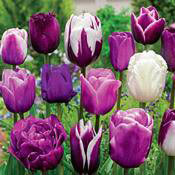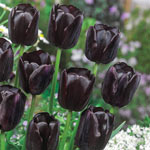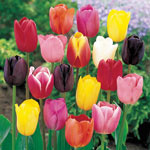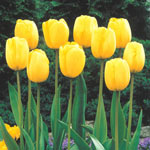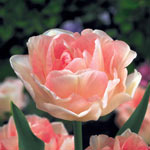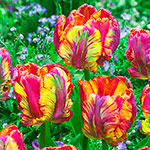Tulips
Tulip Bulbs

Tulip Bulbs From Breck's
When you think of Dutch flowers, what first comes to mind? For many people, it's the tulip! This regal, spring-blooming perennial yields flowers that are usually large and showy, and in such bright colours as red, pink, yellow, or white.Breck's tulip bulbs are grown in Holland and bred to flourish in American gardens. Our Dutch flower experts work with the finest tulip growers to bring you a wide selection of time-tested favourites as well as exciting, new varieties that will add spring colour to your garden. What's more, there's never any risk for you because every one of our tulip bulbs is sold with our no-hassle Breck's Lifetime Guarantee. Our Customer Service team works around the clock to ensure your satisfaction.
Which Tulips Should I Buy?
There are several thousand varieties of tulips available, and more are introduced every year. They are divided into over a dozen groups. When most people think of tulip blooms, they probably imagine the traditional six-petal, cup-shaped flowers. But tulips are available in many different colours, sizes and shapes. Some are dwarf types, some are bicoloured, some have feathery petals, some have star-shaped blooms. Tulips are wonderful for planting along walkways or in front of your home, beside fences and in soring borders. Try growing them in large groups for a spectacular effect.After their first year, tulips can sprout and bloom again the following year from the bulbs in the ground, but many varieties tend to deteriorate over time. A lot of growers like planting Darwinhybrid tulips, which are true perennials that reliably return year after year. These hardy, vigorous flowers produce large, showy blooms with a classic tulip shape, and come in many rich, saturated colours.
Grower's Guide to Planting Tulip Bulbs
Because of their striking appearance and brilliant colour, tulips can be among the most satisfying flowers for a gardener to grow. Whether you plant them as garden borders or in row after row of gorgeous hues, our Dutch-propagated bulbs produce flowers that draw smiles from all who encounter them. Their dramatic green foliage sets off these colourful flowers perfectly. To landscape tulips that perform to their potential, it's critical to plant them properly.When to Plant Tulip Bulbs
Tulip bulbs should be planted in fall before the ground freezes. By planting varieties with different bloom times, you can have tulips blooming from early to late spring. While it is not necessary for hardy perennial varieties, you may choose to lift, or dig up, your tulip bulbs after the foliage has ripened. If you lift, store the bulbs in a dry place during the summer and replant them next fall. When replanting, be sure to use fresh soil to reduce the risk of disease. Each year before replanting, inspect your bulbs for bruises or cuts that may allow diseases to enter and then spread to other bulbs. This is essential since an infection of the incurable fungal disease tulip fire (also called Botrytis blight) will require you to burn all your tulips!Where to Plant Tulip Bulbs
Different tulip varieties offer all sorts of options for your garden, so you may choose the sizes, types and shades that work best for your space. Tulips prefer a site with full or afternoon sun. In Zones 7 and 8, choose a shady site or one with morning sun only, as tulips don't like a lot of heat. Ensure that your soil drains well and is neutral to slightly acidic, fertile, and dry or sandy. All tulips dislike areas with excessive moisture. You'll want to space bulbs 4 to 6 inches apart, so choose a large enough planting site. When growing your tulips in containers, avoid placing them in direct sunshine. The soil needs to remain cool so the bulb doesn't prematurely receive signals that spring has arrived. If the sun warms the soil in the container too early, the bulb will send up shoot and flower before an adequate root system has developed.How to Plant Tulip Bulbs
Most gardeners plant their bulbs in November in full sun. Measuring from the base of the bulb, place your tulips about 6 inches deep in well-drained, moderately loamy soil with some humus and sand added. This will help naturalizing or perennializing, and cut down on the risk of disease and fungus. Water after planting. This will ensure that your tulips develop a strong root system before going into winter dormancy. After flowering, allow bulb foliage to wither before cutting. This lets sap in the foliage return to the bulb, where it provides added strength for next year.How to Grow and Care for Tulips
Tulips are very easy to grow, especially when considering how much beauty they add to their surroundings and how much joy they bring to people. They perform best when compost is applied annually to provide them with nutrients needed for healthy blooms. Tulips should also receive plant food in fall and spring. Get more information and helpful advice by visiting our page on how to grow Tulips.Other Tips and Care Instructions for Tulip Bulbs
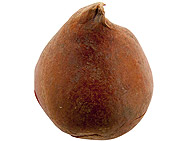
When growing your tulips in containers, avoid placing the container in direct sunshine. The soil needs to remain cool so the bulb doesn¹t prematurely receive signals that spring has arrived. If the sun warms the soil in the container too early, the bulb will send up shoot and flower before an adequate root system has developed. Keeping the soil cool for as long as possible will encourage the strongest and most expansive root system possible.
Perennial tulips are special because, unlike many hybrids, they come back reliably year after year. Besides choosing a truly perennial variety, there are a few steps you can take to ensure perennial performance... Plant bulbs in well-drained soil. This will help naturalizing or perennializing and cut down on the risk of disease and fungus. Plant bulbs deep. Measuring from the base of the bulb, place the tulip about 6" inches deep. Water after planting. This will ensure that your tulips develop a strong root system before going into winter dormancy. After the blossoms have peaked, remove the flower heads and allow the green foliage to die back. Fertilize in fall and spring.
The botanical name of this popular spring flower is derived from the Persian word, toliban, turban, when the inverted flower was supposed to resemble. It does belong to the Lily Family and grows wild over a great territory from Asia Minor through Siberia to China. Tulips are very easy to grow. Most gardeners plant their bulbs in November in full sun. Place your tulips about 6" deep in moderately loamy soil with some humus and sand added. After flowering, allow bulb foliage to wither before cutting - that way, sap in the foliage returns to the bulb where it provides added strength for next year.
Care in Lifting - You may choose to lift your tulips after the foliage has ripened. This is not necessary with hardy perennial varieties. If you lift, store the bulbs in a dry place during the summer and replant them next fall in fresh soil - this will reduce the risk of disease. Each year before replanting, inspect your bulbs for bruises or cuts that may allow diseases to enter and then spread to other bulbs. This is essential since an infection of the incurable disease 'Fire' (Boyrytis) will require you to burn all your tulips!
Perennial tulips are special because, unlike many hybrids, they come back reliably year after year. Besides choosing a truly perennial variety, there are a few steps you can take to ensure perennial performance... Plant bulbs in well-drained soil. This will help naturalizing or perennializing and cut down on the risk of disease and fungus. Plant bulbs deep. Measuring from the base of the bulb, place the tulip about 6" inches deep. Water after planting. This will ensure that your tulips develop a strong root system before going into winter dormancy. After the blossoms have peaked, remove the flower heads and allow the green foliage to die back. Fertilize in fall and spring.
The botanical name of this popular spring flower is derived from the Persian word, toliban, turban, when the inverted flower was supposed to resemble. It does belong to the Lily Family and grows wild over a great territory from Asia Minor through Siberia to China. Tulips are very easy to grow. Most gardeners plant their bulbs in November in full sun. Place your tulips about 6" deep in moderately loamy soil with some humus and sand added. After flowering, allow bulb foliage to wither before cutting - that way, sap in the foliage returns to the bulb where it provides added strength for next year.
Care in Lifting - You may choose to lift your tulips after the foliage has ripened. This is not necessary with hardy perennial varieties. If you lift, store the bulbs in a dry place during the summer and replant them next fall in fresh soil - this will reduce the risk of disease. Each year before replanting, inspect your bulbs for bruises or cuts that may allow diseases to enter and then spread to other bulbs. This is essential since an infection of the incurable disease 'Fire' (Boyrytis) will require you to burn all your tulips!









